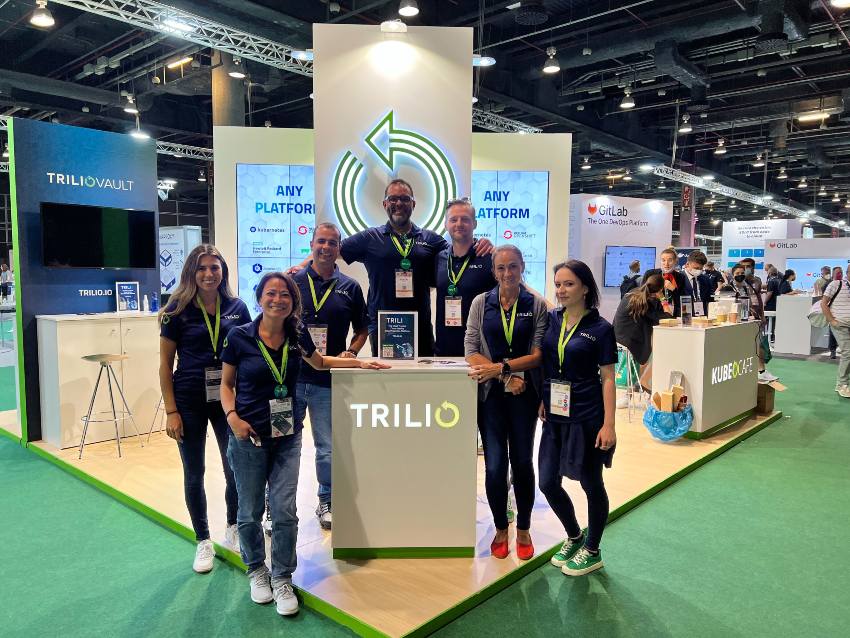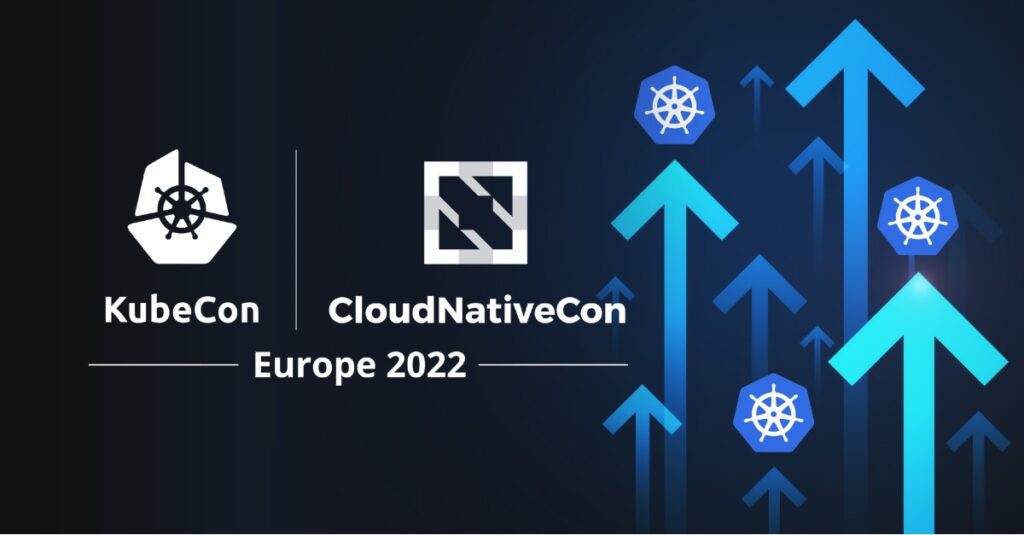By Trilio Content Team | June 3, 2022
It’s a wrap on KubeCon + CloudNativeCon Europe 2022, and what an event it was! From thought-provoking keynotes that drive Kubernetes into the future to exciting announcements from top players, it was a jam-packed experience for attendees far and wide.
Thankfully, the learnings don’t stop just because the event is over. Now is the time to dig into the sessions and conversations that make you excited to be part of the cloud-native community.
5 Key Takeaways from KubeCon & CloudNativeCon Europe

Team Trilio at KubeCon Europe 2022
Didn’t make the conference? Need a refresh? Fear not! Below, you’ll find takeaways from 2022’s KubeCon, challenges facing many in the cloud-native world, and the resources you need to solve them.
So you can explore it all with fresh eyes, whether you attended or not, and make your cloud-native journey a successful one.
1. Cloud-Native Adoption Continues to Climb
Each year, cloud-native adoption keeps going up—from the number of developers using Kubernetes to the amount of Cloud Native Computing Foundation (CNCF) projects in the works.
But don’t take our word for it; let the numbers speak for themselves. According to the keynotes…
- 5.6 million developers were using Kubernetes at the end of 2021, a number that is likely even higher now.
- There are now 128 CNCF projects, up from 114 just six months ago.
- 65% of KubeCon EU 2022 attendees were first-timers, indicating explosive growth and interest in the space.
And it’s not just adoption overall that’s rising. More organizations than ever are using containers in production, a trend that IDC predicts will rise to 70% by 2024. If the conversations at KubeCon are any indication, this prediction will come true sooner rather than later.
For example, in the many conversations that Trilio’s cloud-native experts had in Valencia, an estimated 80% of organizations were already running containerized apps in production, with another 20% planning on doing so or considering doing so in the near future.
While that is exciting, it leads to challenges, like the skills gap in the industry. One keynote pointed out that Kubernetes developers vastly outnumbered security engineers, leaving potential gaps in security that could put your applications at risk.
That’s why it’s so important to build resilient apps right from the start. So your developers are thinking about data security and protection the second they start building.
Want to perfect your data protection strategy? This guide outlines the benchmarks you need to boost your cloud-native application resiliency.
2. Disaster Recovery is Increasingly Important
As adoption grows, another trend came to light: More organizations are running stateful applications inside containers. And that means disaster recovery is more important than ever.
Why? Because stateful apps depend on context. They may refer to and depend on a transaction that happened before, and the current transaction can affect what happens in future ones. That history and storage are critical for keeping your application functioning for end users. So you have to have a robust backup and recovery strategy.
At KubeCon and CloudNativeCon Europe, our K8s experts got tons of questions about disaster recovery for stateful apps. In these conversations, they found that a lot of organizations don’t have a disaster recovery strategy that they test quarterly. ?
You don’t want to leave your disaster recovery to chance or use a legacy solution that requires you to manually stitch together snapshots as your customers grow frustrated. Instead, your data protection solution should help you recover from any disaster quickly and easily.
With Trilio, you can write point-in-time copies to secondary targets or clouds and set up disaster recovery plans that fit your needs. If you’re ready to protect your stateful, containerized apps, we got you covered with new innovations in Disaster Recovery for cloud-native environments.
Learn more about how you can continuously stage data at multiple and heterogeneous clouds. This means applications—regardless of where they reside—can tap into that data and be brought online in seconds, achieving exceptional levels of Recovery Time Objectives (RTO).
3. Migration Matters in a Multi-Cloud World
As more organizations tap into the power of cloud-native tech, they’re taking advantage of the many cloud providers out there. This multi-cloud world comes with benefits like flexibility, but it also comes with challenges. One of them is how difficult it is to migrate data between clouds.
According to the conversations our K8s experts had at KubeCon and CloudNativeCon Europe, many organizations with multi-cloud infrastructure struggle with this. If they want to back up to a separate cloud or change or upgrade K8s distributions, it isn’t easy or affordable to do so.
Thankfully, this challenge is solvable; you just need the right data protection platform. Trilio is platform agnostic, making it easy to migrate between distributions, across clouds, from on-prem to a public cloud, and more.
And we make migration even more seamless by capturing not just your data but your metadata and all associated objects.
Maximize your multi-cloud environment in Kubernetes today. Chat with an expert or take TrilioVault for Kubernetes for a spin now.
4. Cloud-Native Innovation Knows No Bounds
When you think about cloud-native technology, does innovation come to mind? It should. This year’s conference put a spotlight on the various ways cloud-native computing can help us build a better future.
Here are just a few of these exciting projects.
Building a sustainable future
Cloud-native technology is revolutionary in so many ways, but is it helping or hurting our carbon footprint?
Intel’s keynote took on the topic of sustainability, pointing out how much energy data centers consume, trajectories for energy and Internet usage in the future, and how software developers and cloud-native professionals can build more sustainable applications.
Powering space
Cloud-native technology is expanding beyond the globe—it’s now in space. Huawei, a telecommunications company based in China, is combining space technology with cloud native and AI to help analyze data from satellites.
These satellites generate millions of information and images, much of which has a direct impact on end users. Think about images on maps, for example. By using cloud-native technology, they can analyze mass amounts of data faster and more efficiently.
This is just the tip of the iceberg of what cloud-native technology can do. What will you use it for?
5. We’re On This Journey Together
One final trend from KubeCon 2022 is the true community that exists in the cloud-native world. And it’s still a new, evolving world that we’re all learning more about. Priyanka Sharma, the executive director of CNCF, reminded the community of this in her opening remarks.
“Being a learner is something to be proud of.”
Because of this, there’s a real sense of camaraderie. In fact, our team went out of their way to point out how respectful and considerate their conversations were with each and every person.
As we all walk down our cloud-native journeys, may this spirit of togetherness continue to bind us. After all, we can make cloud-native ubiquitous if we continue to collaborate and communicate.
Resources to Help You on Your Cloud-Native Journey
Here are some helpful resources to keep you learning and growing post-KubeCon and beyond.
- To learn about cloud-native projects, training, resources, community, and more, check out Cloud Native Computing Foundation
- To see keynotes and lightning talks from this year’s KubeCon, head over to Cloud Native Computing Foundation’s YouTube channel
- For more reasons, you need to protect your cloud-native applications, read Top 4 Reasons Cloud-Native Data Protection is Essential for Kubernetes Container Success
Did you go to KubeCon + CloudNativeCon Europe 2022? What were your top learnings from Valencia? Share in the comments.

